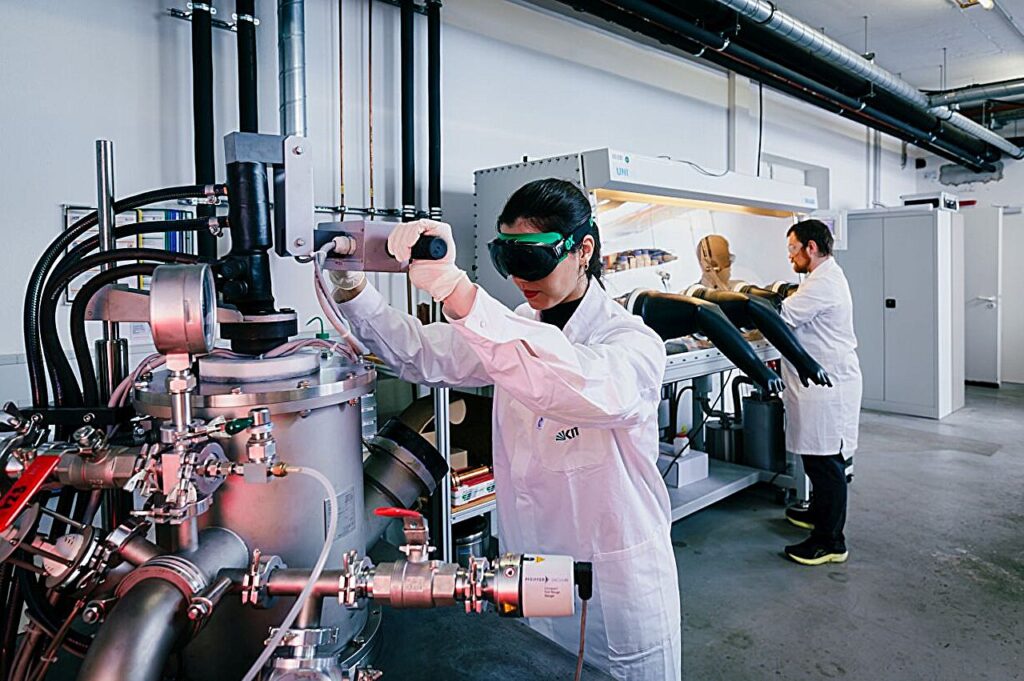A new material might contribute to a reduction of the fossil fuels consumed by aircraft engines and gas turbines in the future. A research team from Karlsruhe Institute of Technology (KIT) has developed a refractory metal-based alloy with properties unparalleled to date.
The novel combination of chromium, molybdenum, and silicon is ductile at ambient temperature. With its melting temperature of about 2,000°C, it remains stable even at high temperatures and is at the same time oxidation resistant. These results are published in Nature.
High-temperature-resistant metallic materials are required for aircraft engines, gas turbines, X-ray units, and many other technical applications. Refractory metals such as tungsten, molybdenum, and chromium, whose melting points are around or higher than 2,000°C, can be most resistant to high temperatures.
Their practical application, however, has limitations: They are brittle at room temperature and, in contact with oxygen, they start to oxidize, causing failure within a short time already at temperatures of 600°C to 700°C. Therefore, they can only be used under technically complex vacuum conditions—for example, as X-ray rotating anodes.
Due to these challenges, superalloys based on nickel have been used for decades in components that are exposed to air or combustion gases at high temperatures. They are used, for example, as standard materials for gas turbines.
“The existing superalloys are made of many different metallic elements, including rarely available ones, so that they combine several properties. They are ductile at room temperature, stable at high temperatures, and resistant to oxidation,” explains Professor Martin Heilmaier from KIT’s Institute for Applied Materials–Materials Science and Engineering.
“However—and there is the rub—the operating temperatures, i.e., the temperatures in which they can be used safely, are in the range up to 1,100°C maximum. This is too low to exploit the full potential for more efficiency in turbines or other high-temperature applications. The fact is that the efficiency in combustion processes increases with temperature.”

A chance for a technological leap
This limitation existing with the materials available today was the starting point for Heilmaier’s working group. Within the “Materials Compounds from Composite Materials for Applications in Extreme Conditions” (MatCom-ComMat) research training group, the researchers succeeded in developing a new alloy made of chromium, molybdenum, and silicon.
This refractory metal-based alloy, in whose discovery Dr. Alexander Kauffmann, now professor at the Ruhr University Bochum, played a major role, features hitherto unparalleled properties. “It is ductile at room temperature, its melting point is as high as about 2,000°C, and—unlike refractory alloys known to date—it oxidizes only slowly, even in the critical temperature range.
“This nurtures the vision of being able to make components suitable for operating temperatures substantially higher than 1,100°C. Thus, the result of our research has the potential to enable a real technological leap,” says Kauffmann.
This is specifically remarkable as resistance to oxidation and ductility still cannot be predicted sufficiently to allow a targeted material design—despite the great progress that has been achieved in computer-assisted materials development.
More efficiency, less consumption
“In a turbine, even a temperature increase of just 100°C can reduce fuel consumption by about 5%,” explains Heilmaier. This is particularly relevant to aviation, as airplanes powered by electricity will hardly be suitable for long-haul flights in the next decades. Thus, a significant reduction of the fuel consumption will be a vital issue. Stationary gas turbines in power plants could also be operated with lower CO₂ emissions thanks to more robust materials.
“In order to be able to use the alloy on an industrial level, many other development steps are necessary,” says Heilmaier. “However, with our discovery in fundamental research, we have reached an important milestone. Research groups all over the world can now build on this achievement.”
More information:
Frauke Hinrichs et al, A ductile chromium–molybdenum alloy resistant to high-temperature oxidation, Nature (2025). DOI: 10.1038/s41586-025-09516-8
Citation:
Novel alloy withstands extreme conditions, could replace metals used in aircraft engines and gas turbines (2025, October 9)
retrieved 12 October 2025
from https://techxplore.com/news/2025-10-alloy-extreme-conditions-metals-aircraft.html
This document is subject to copyright. Apart from any fair dealing for the purpose of private study or research, no
part may be reproduced without the written permission. The content is provided for information purposes only.

